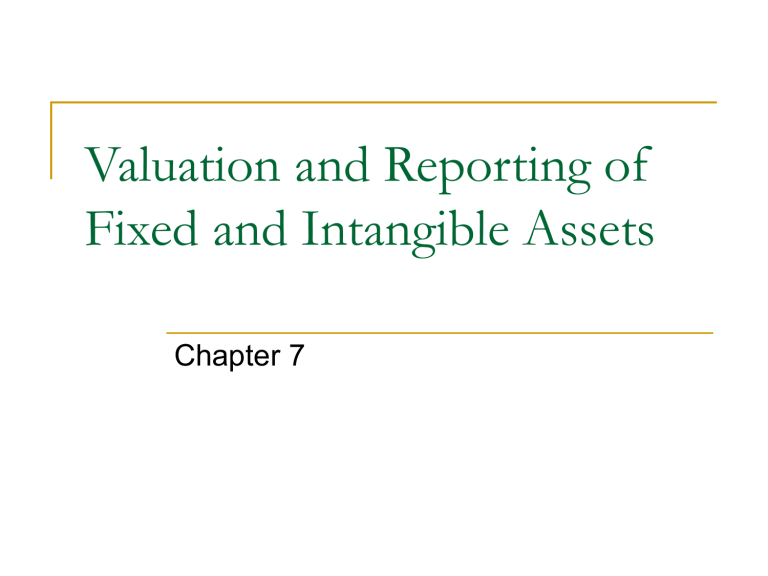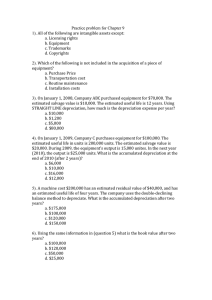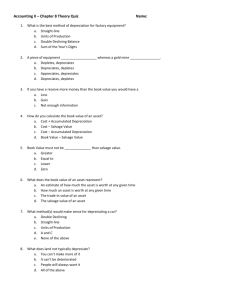Chapter 7

Valuation and Reporting of
Fixed and Intangible Assets
Chapter 7
Fixed Asset Cost
The cost of a fixed asset includes all reasonable and necessary costs to get the asset in place and ready for its intended use
Costs that do not increase the asset’s usefulness are treated as expenses
Depreciation
Depreciation is a process of allocation, not valuation
Purpose is to allocate the cost of the asset over the periods in which it will provide benefits
No attempt is made to adjust the asset’s cost to approximate its current value
Depreciation expense is based on estimates of the asset’s useful life and salvage value
Only the original cost is known with certainty
Depreciation
Various methods of calculating depreciation are acceptable
Straight line method
(Cost – salvage value) / useful life
Units of output method
(Cost
– salvage value) / total expected output * current output
Accelerated methods
Declining balance method
Sum of the years’ digits method
Depreciation
Double declining balance method
Straight line rate is calculated by dividing 100% by the useful life and doubling that rate
The rate is multiplied by the book value each year to determine the depreciation expense
Depreciation stops when the salvage value is reached
Depreciation
Example
An asset with a cost of $24,000 and an estimated salvage value of $2,000 is expected to have a useful life of 8 years
100% / 8 years * 2 = 25%
8
9
6
7
Year Book value
1 $ 24,000
2
3
4
5
18,000
13,500
10,125
7,594
5,695
4,271
3,204
2,403
Rate
25%
25%
25%
25%
25%
25%
25%
25%
Expense
$ 6,000
4,500
3,375
2,531
1,898
1,424
1,068
801
403
Accumulated depreciation Book value
$ 6,000
10,500
$ 18,000
13,500
13,875
16,406
18,305
10,125
7,594
5,695
19,729
20,796
21,597
22,000
4,271
3,204
2,403
2,000
Subsequent Expenditures
Various types of expenditures are made after a fixed asset has been acquired
Revenue expenditure
Normal maintenance to keep the asset operating as designed
Does not add to the asset’s value, improve its functionality, or extend its life
Treat as an expense
Subsequent Expenditures
Capital Expenditure
Increase the asset’s life, improve its capacity, or increase its value
Replacement of major components or addition of new components
Treat as an additional cost of the asset
Capitalize and depreciate
If a replacement of an existing component, write off the remaining value of the component being replaced as depreciation expense
Disposal of Fixed Assets
Steps in accounting for the disposal
Update depreciation to the date of the disposal
Compare book value to selling price (if any) to determine any gain or loss
Remove the asset’s original cost and its accumulated depreciation from the books, and record the cash received and any gain or loss
Intangible Assets
Provide future benefits but have no physical substance
Usually some sort of legal right
Patents, copyrights, trademarks, franchise fees, leaseholds, goodwill, etc.
Recorded at original cost
Amortized using the straight line method
No salvage value
No accumulated amortization account
Asset account is reduced directly
Presentation of Fixed Assets
Property, plant and equipment
Show at cost, less accumulated depreciation
Intangibles
Show at depreciated cost






